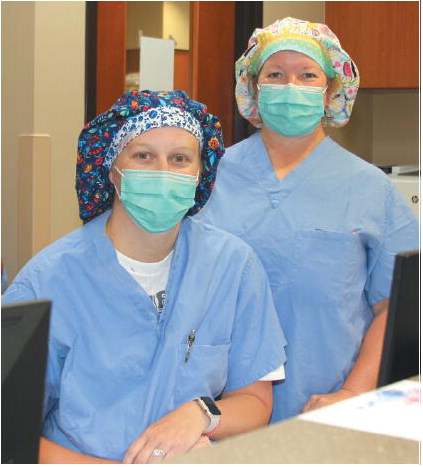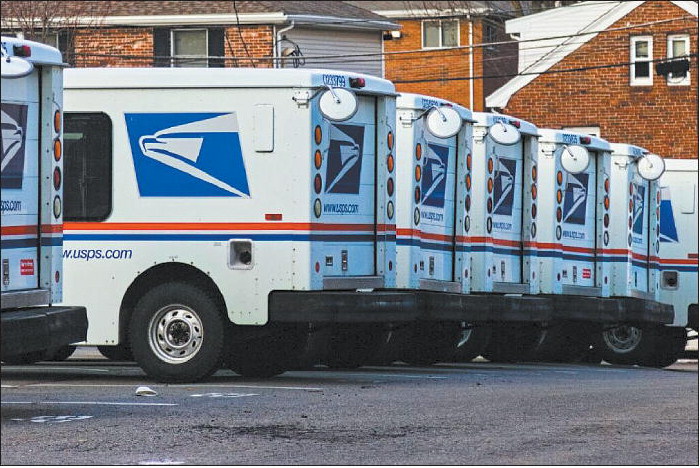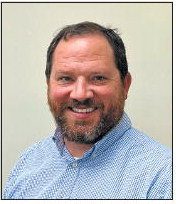TheFutureIsNow:
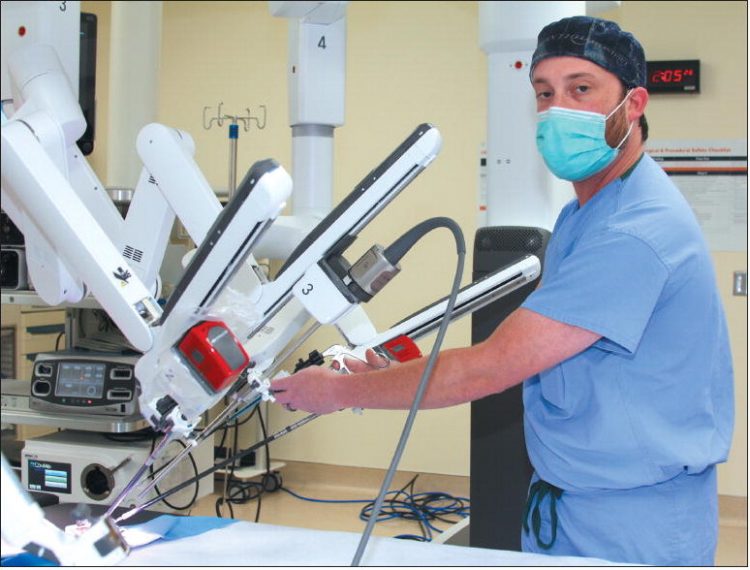

Robotic surgery may sound futuristic, but this kind of state-of-the art medicine is now practiced almost on a daily basis at Memorial Health Meadows Hospital in Vidalia. Medical professionals agree that robotically-assisted surgery is more precise, less invasive, and conducive to a faster recovery with less discomfort for the patient. And now, since this surgery is readily available closer to home for area residents, it is not necessary to commute long distances to larger facilities for treatment and care, said Meadows Hospital CEO Matt Hasbrouck. The first robotically-as- continued from page
sisted surgery at Meadows was performed in January, and to date, over 210 such procedures have been completed locally using Intuitive Surgical’s da Vinci robotic surgical system.
These procedures have been performed by general surgeons Dr. Kendrix Evans, Dr. Henry Ferland, and Dr. Alex Wynn, as well as by Dr. Susanna Meredith and Dr. Ashley Nicole Tillery, obstetricians/ gynecologists, and bariatric surgeon Dr. Oliver Whipple.
Dr, Ferland, who served his medical residency in Boston, said he and Dr. Evans were attracted to Meadows to practice medicine because of its forward momentum. “Having a community this size with a tool like the da Vinci robot is unheard of. Neither of us had heard of a rural, community hospital with equipment like this.”
Dr. Ferland received his medical degree from the University of New England in Biddeford, Maine, and completed his residency at St. Elizabeth's Medical Center in Boston. Dr. Evans received his medical degree from the Morehouse School of Medicine in Atlanta. He then completed his residency at the University of Utah and went on to complete his fellowship at the University of Mississippi Medical Center in Jackson, Mississippi.
The range of surgeries using the da Vinci robot is impressive. The general surgery procedures include cholecystectomies, appendectomies, and several types of hernia procedures. Bariatric surgery has included gastric bypasses and gastric sleeves, and gynecological surgery has included hysterectomies, ovarian cystectomies, oophorectomies, salpingectomies, and diagnostic laparoscopy.
Dr. Evans, who said that approximately 15 cases of robotically-assisted surgery occur each week at Meadows, explained that the precision made possible with this type of surgery offers distinct advantages. “Anytime you do something minimally invasive, there is a lot less pain.”
Doctors use technology to enhance their capabilities; for instance, MRIs and CT scans allow physicians to see inside the patient’s body. Robotically- assisted surgery and laparoscopic surgery are similar procedures which further extend the surgeo’s capabilities. Both are minimally invasive, and both use cameras with microscopic magnification.
Laparoscopic surgery is more “hands on” with the surgeon guiding the instruments at the operating table, but, with robotic surgery, the surgeon controls the robot’s movement — and the entire procedure — from a console within the operating room several feet away from the operating table. Robots Don’t Operate, Doctors Do The term “robotic” often misleads people. Robots don’t actually perform surgery. The surgeon performs surgery with the da Vinci system by using instruments that he or she guides via the console. The da Vinci system translates the surgeon’s hand movements at the console in real time, bending and rotating the instruments while performing the procedure. The tiny, wristed instruments move like a human hand, but with a greater range of motion. The system’s built-in tremor filtration technology helps surgeons move instruments smoothly.
The da Vinci vision system also delivers highly magnified, 3D high-definition views of the surgical area — magnified 10 times more than what the human eye sees. The instrument size makes it possible for surgeons to operate through one or a few small incisions.
“The 3-D camera that is part of the robotic system is amazing regarding the level of what you can see. We are able to stop micro-bleeds and manage tissue problems you wouldn’t necessarily see laparoscopically,” Dr. Evans said.
In robotically-assisted surgery, attachments called trocars are linked to the robot. Different types of tools can be fitted onto the ends of the trocars that are then inserted into the patient through one or more tiny incisions. A console microphone allows the surgeon to interact with the rest of the surgical team, including the nurses and anesthesiologists, who are near the patient or performing other tasks within the operating suite.
The da Vinci system has three main components: the console where the surgeon controls instruments while viewing anatomy in high-definition 3D; the patient cart, which is positioned alongside the operation table and holds the camera and instruments that the surgeon controls from the console; and the vision cart, which enables communication between components and supports the 3D high-definition vision system. In addition to the surgeon, the surgical team includes two or more nurses and technologists, as well as an anesthesia team. It is the responsibility of the team to monitor the vision cart, other instrumentation, and the patient as the surgeon performs the procedure.
Dr. Evans, who often
THE CORE – Janna Tabor stands in a room adjacent to the operating room that staffers refer to as “the core” where supplies and instrumentation needed for robotic procedures are stored.
uses laparoscopy, said he does not see a day in the near future where surgeries will be performed 100% by robot, but he does think the robot will one day take the place of laparoscopic surgery. “Right now, I think of them (robotic and laparoscopic surgery) as two separate entities, but I also think of them as a combination of technology — adjunctive rather than counter balancing one another.”
Dr. Evans has performed numerous gallbladder procedures using
the procedure.
the robot and emphasizes the advantages the microscopic views inside the body the robot affords. “In gallbladder surgery I can see the ductal anatomy. It lights up for you. I have seen aberrant anatomy I would not have noticed without the detail provided by the robot,” the surgeon said.
Benefits of Robotically-Assisted Surgery
“We are actually able to see the benefits of robotically- assisted surgery in patient outcomes. The patient’s level of pain is minimized and their return to work and an active life is faster,” Evans stated.
Dr. Ferland acknowledged that at first he was a little skeptical about what a marked difference the robotically-assisted surgery could make in a patient’s recovery time until he witnessed the results for himself. “We see it in real life,” he said, noting that recovery from hernia surgery, depending on the patient, can take weeks or months, but he has seen patients who had robotically- assisted procedures bounce back much more quickly — some in less than two weeks — and with less discomfort.
He also explained that with robotic-assisted surgery, extra testing and equipment can often be eliminated. “For instance, without the robot, we may have to do an x-ray to determine the medical issue, which adds to the length of the case.”
“The robot can bring a lot of things,” Dr. Ferland pointed out. Having cutting- edge equipment will attract other new practitioners, he emphasized.
“This will not only help the patient, but their families, too,” the surgeon said. “We are not one and done with the type of surgery we do. We see patients for months or up to a year after surgery,” he said, referencing the preoperative to postoperative phases of treatment. If the continued from page
patient receives care away from home, family members have to travel back and forth to the facility where the patient is being treated.
“We offer comprehensive surgical services right here, close to home. We look forward to the opportunity to serve and care for you or your loved ones.” Dr. Ferland added, “Research shows that living near where the surgery is done shows a better outcome for patients and their families.”
Dr. Evans said of the robotically-assisted surgery, “It makes us more marketable. To have this equipment in Vidalia is immeasurably beneficial because we are able to compete with larger markets. This has broadened our horizons and allows people to see we are capable of doing so much more here.”
Hasbrouck said, “We are blessed to have the medical talent we have at Meadows Hospital. Dr. Evans and Dr. Ferland are highly skilled, and we recommend partnering with them to quarterback your general surgery healthcare needs.” He stressed that the surgical team that assists the general surgeons and other surgeons using the robot are well trained and have been working together for several months to perfect their procedures.
“Nine times out of ten, our surgeons can address any medical situation, and they have deep relationships with other surgeons in subspecialties, so they can easily access additional resources when needed.” Hasbrouck said, adding, “We encourage community members to build their health care through these surgeons and medical resources locally at Meadows Hospital.”
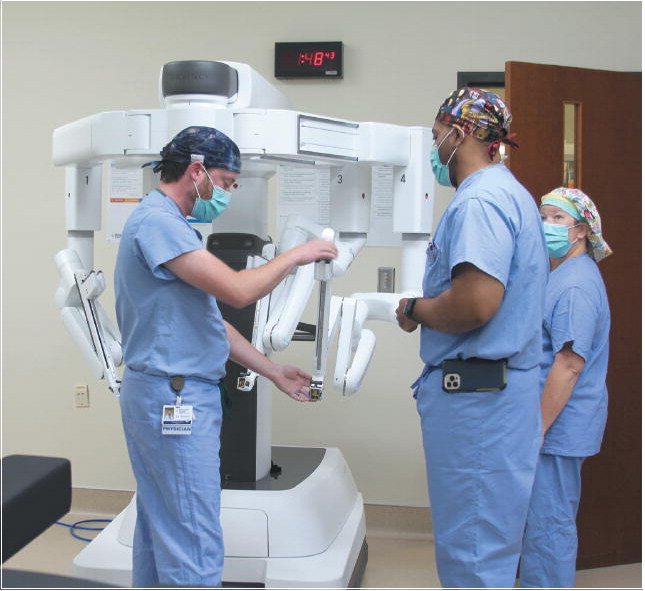
ROBOTIC ARM – Dr. Ferland manipulates the robotic arm while Dr. Evans and Director of Surgical Services Jennifer Wolfe observe.
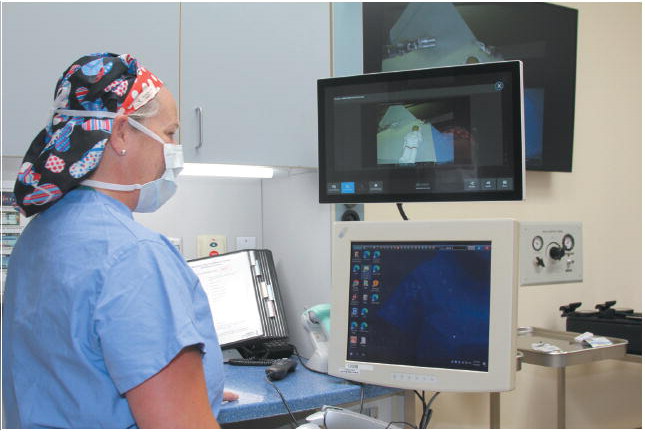
DOCUMENTATION STATION – Janna Tabor works at the documentation station with a video display of the robotic image. The “vision cart” makes communication between components possible and supports the 3D high-definition vision system.
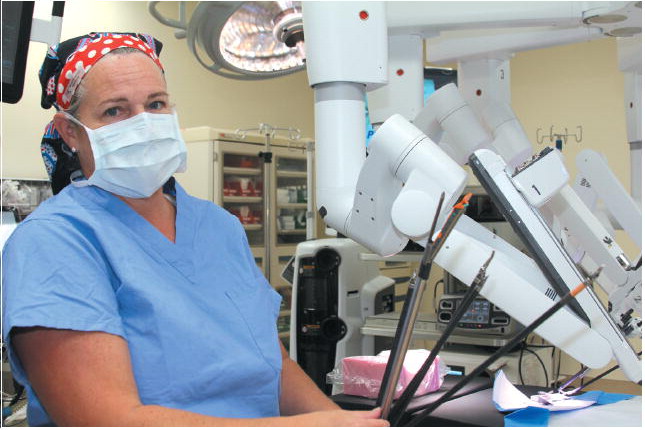
INSTRUMENTATION – Robotics Clinical Nurse Coordinator Janna Tabor displays assorted robotic instrumentation.
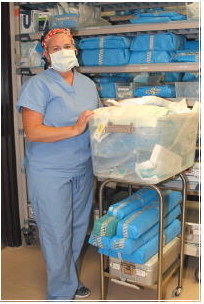
PART OF THE TALENT- Dr. Evans stands with Lisa Butler, a member of the MHMH Central Sterile Team.
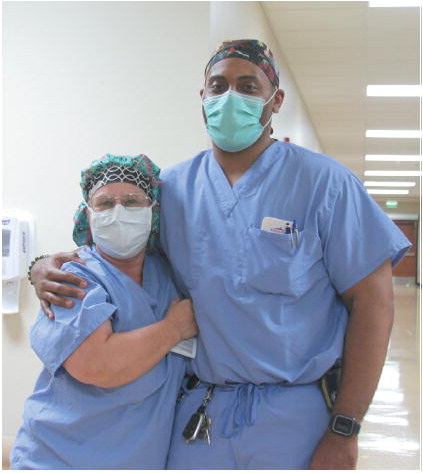
PATIENT CART – Dr. Ferland drives the patient cart that will be docked to the patient. Positioned alongside the bed, the patient cart holds the camera and instruments that the surgeon controls from the console.
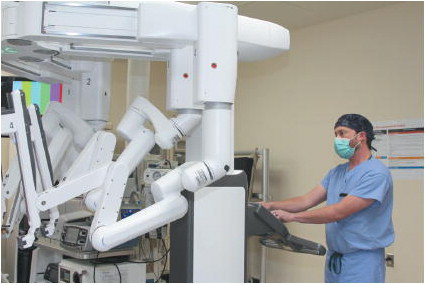
AT THE CONSOLE – Dr. Evans, seated at the console, manipulates hand controls. The da Vinci system translates the surgeon’s hand movements at the console in real time, bending and rotating the instruments while performing
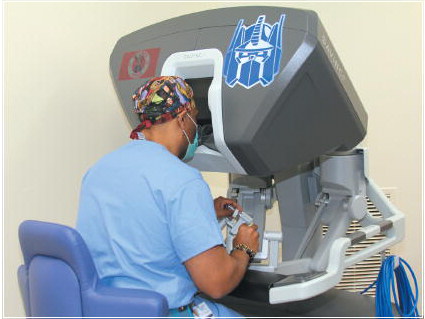
SURGEONS – Dr. Kendrix Evans, left, and Dr. Henry Ferland, have been performing robotically-assisted surgery at Memorial Health Meadows Hospital since January, and at this point have completed over 200 operations using the da Vinci Robot.
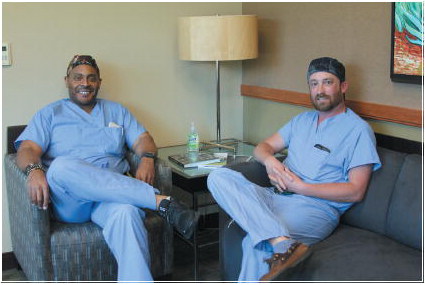
SYSTEM COMPONENTS – Dr. Evans displays reusable cannulas. In robotically-assisted surgery, attachments called trocors are linked to the robot. Different types of tools can be fitted onto the ends of the trocars that are then inserted into the patient through one or more tiny incisions.
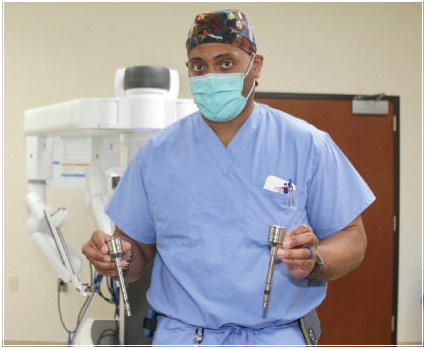
TEAMWORK – A well-trained surgical team is critical to good outcomes in the surgical process. Members of the robotically-assisted surgical team at MHMH are, from left, Operating Room Manager Danielle Lockley and Director of Surgical Services Jennifer Wolfe.
